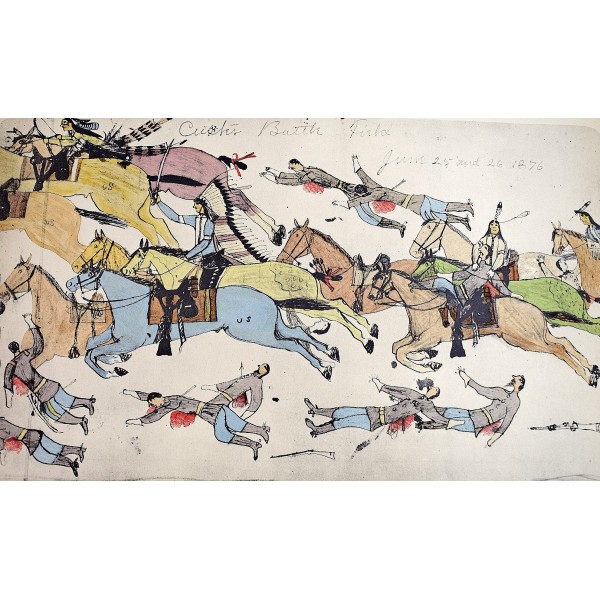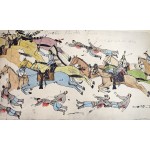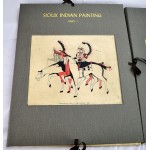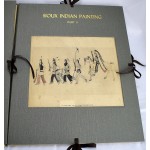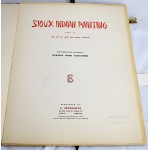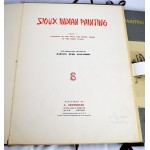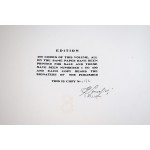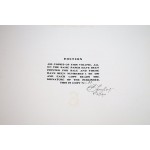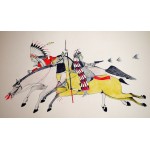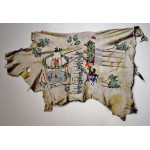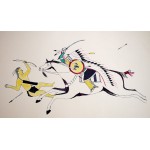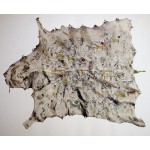Sioux Indian Painting (2 volumes)
Sioux Indian Painting (2 volumes)
Amos Bad Heart Bull; Hartley Burr Alexander
C. Szwedzicki, 1938
2 portfolio volumes. Limited edition of 400. Signed by publishers, C. Szwedzicki and V. Crespin. Complete, 51 plates on 50 sheets. Loose as issued. Plates slightly toned. Original boards, rebacked. Ex-library, perforated stamp at foot of title pages, plates free of library markings. In gorgeous custom-made Native American inlaid leather slip case.
Contents: Vol. I: Painting of the Sioux and Other Tribes of the Great Plains. Vol. II: The Art of Amos Bad Heart Buffalo.
Goetzmann & Goetzmann, The West of the Imagination, p. 221: "Besides the verbal accounts of the Little Big Horn Battle, the only visual records are those left by the Indians. Of these, the principal one is a long series of drawings done by the Oglala Sioux, Amos Bad Heart Buffalo, who was only six at the time of the battle, but who became the tribal historian... Bad Heart Buffalo's series is a masterful piece of primitive ledger art." Dorothy Sloan wrote a masterful description of this work in her 2007 Auction, Custer's Last Stand: Images & Perceptions from the Other Side: "The portfolios were instrumental in promoting and recognizing the worth of Native American art. Having its genesis in the 1931 Exposition of Indian Tribal Art that was mounted at Grand Central Art Galleries, this publication is one of the most significant renderings of Native American art, presenting works painted by several important artists, including Amos Bad Heart Buffalo (1869-1913). Part of their significance is that they show history from the Native American viewpoint, one considerably rarer than that presented by their more prolific American and European counterparts who roamed the West in search of subjects and displayed their works in galleries on both sides of the Atlantic. The exhibition and this publication presented Native American paintings as works of art rather than mere ethnographic curiosities to be studied for such details as costumes and customs, probably for the first time. This change was part of the quest at the time for art that was uniquely American, rather than American art that looked like it could have been painted in Europe. These paintings also captured events and persons not witnessed or recorded by others, especially the impatient Anglos who were overrunning the land and culture of Native Americans.
The volume editor, Hartley Burr Alexander, provides a valuable introduction on Native American art and the place these images have in it. He considered the Plains Indians, whose work is shown here, to be the most accomplished of all Native American artists and lamented that their earlier works had vanished because of the fragile media on which they were originally executed. He also believed that the artists presented here were among the most significant Native American painters and that their works represented the apex of their craft. While admitting that the artists often painted in a non-realistic manner and sometimes concentrated on symbolism, he also argued persuasively that the artists were assuredly artists who deserved respect and admiration for their skills and techniques. Among the somewhat unrealistic features he noted was the Native American practice of rarely including realistic facial features, which, as he notes, rarely change from image to image. On the other hand, he remarks with some admiration on the skill with which the artists depict animals. He seems to harbor few doubts about the accuracy of the diurnal details of dress and custom that the paintings portray. He is particularly redolent in his praise for the painting and compositional skills of Amos Bad Heart Buffalo, who did the images in the second volume, including one of himself as a cowboy trailing a herd. Alexander gives a brief explanation of what is depicted in every image, sometimes with short critical commentary.
The subjects treated in the paintings range widely, from legends, to daily activities, to portraits of famous leaders, to religious ceremonies (including the peyote ritual). Even a freak accident is depicted. Probably none of the images are more famous, however, than those in the second volume depicting the Battle of the Little Big Horn, the only surviving images of that famous encounter. It is impossible, of course, that the artist could have witnessed the events depicted, but he seems to have learned in detail about the action from his relatives who participated (his father Tatanka Cante Sice and his uncle He Dog, both Oglala warriors). In addition to the otherwise realistic details captured in many of the paintings here, these battle scenes are especially graphic, complete with all the violence, blood, and confusion that must have surrounded Reno's retreat back across the Little Big Horn River after his charge was overwhelmed. The artist depicts this moment in several images, along with some others showing the attack on Custer's column. Those images, which are highly different from those of the same event by American artists who tended to focus on the heroic Custer, are juxtaposed with other highly symbolic ones, such as an encounter between Custer and Sitting Bull that never happened. Finally, a map of the battlefield by the artist is also reproduced here."
Ref: Howes A-116. Luther Highspot 105.
This is an oversized or heavy book, that requires additional postage for international delivery outside the US.
